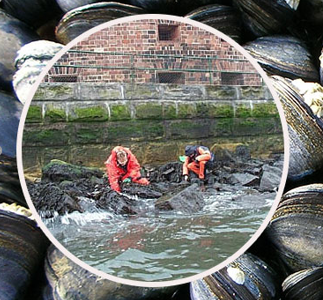We are building models to assess relationships between chemical contamination in the environment and human activity. By evaluating variables such as land use, population density, community infrastructure and business locations, these models will help predict where future monitoring should occur to better inform contamination remediation efforts.
Why We Care
Monitoring programs are expensive and logistically challenging, especially in a world where new potential chemical contaminants are created and produced each year. Remote sensing and other monitoring programs that lend insight into the patterns of the ultimate sources of these chemicals can help optimize existing monitoring resources by targeting suspected areas or chemicals of concern.
What We Are Doing
We aim to:
- Create one or more models to predict which classes of contaminants may be present in the environment as a result of human land use patterns and demographics.
- Provide a baseline list of which contaminants are available for transport to nearby estuarine and coastal environments following significant rain events based on land use and human activities.

Collecting mussels to measure contaminant levels in their tissues. Credit: NOAA. - Identify spatial data gaps in NCCOS contaminant monitoring programs to aid the prioritization of future field testing.
The research will occur in three phases:
- Scoping: What data are available on contaminants and their known sources?
- Modeling: What quantitative and geospatial relationships are there between human activity patterns and contaminant levels?
- Identifying Data Gaps: Are there areas predicted to contain contaminants that are not regularly monitored?
Chemical behavior patterns vary widely, as does regular monitoring and recognition of which contaminants are the most important to monitor. Therefore, we anticipate needing a collection of models instead of a single, all-purpose approach. We will consider three tiers of chemical types:
- Tier 1: Persistent, common contaminants with regular quantitative monitoring, such as polycyclic aromatic hydrocarbons (PAHs). These chemicals should also have known anthropogenic sources and environmental behavior.
- Tier 2: Classes of chemicals that have wide distribution, grouped by similar behavior in the environment and source locations, but that are more data limited in time and space, for example flame retardants, anti-stick kitchen gear treatment, and some pharmaceuticals.
- Tier 3: Classes of chemicals that are data limited due to sparse distribution or limited monitoring efforts.
The models and maps we produce for this project will identify areas that could benefit from additional chemical testing and highlight the use of long-term broad-scale social and demographic monitoring. The set of models will provide a toolkit for future researchers to use in other regions or for new chemicals of emerging concern.
Benefits of Our Work
This project advances the science of integrating data sources from both social and natural science monitoring programs. This integration has the potential to bring efficiency in both sets of monitoring programs, as well as create new insights that come from looking at an age-old problem through a new lens. The results will improve NCCOS’s detection and monitoring capabilities by predicting locations of contamination and adding contaminants of emerging concern to the portfolio of vulnerability assessments that NCCOS develops for coastal communities.
Next Steps
We are currently establishing quantitative relationships for polycyclic aromatic hydrocarbons, persistent environmental pollutants with an extensive data record. The next step will be to apply lessons from this data-rich environment to chemicals of emerging concern.
